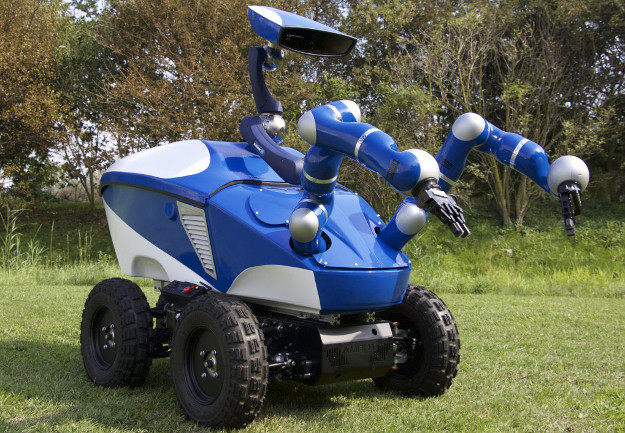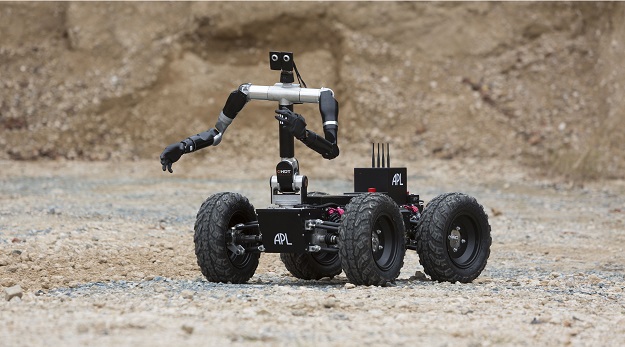News Releases
ESA "Interact Centaur" Rover
September 2nd, 2015 View External LinkAMBOT Platform 4400

27 August 2015 - Early September will see the very first force-feedback-based teleoperation of a rover-based robotic arm system on Earth from the International Space Station, orbiting 400 km above our heads.
Danish ESA astronaut Andreas Mogensen will take control of the Interact Centaur rover, which incorporates a pair of arms to perform precision operations.
In the process Andreas will make use of haptic control – providing him with force feedback to let him feel for himself as the robotic arms encounter resistance. In this way, he can perform dexterous mechanical assembly tasks in the sub-millimetre range, remote-controlled from space.
“When we humans have to perform precision operations, for instance simply inserting our key into the lock of our door, we are relying largely on our feeling of tactile and force receptors in the hand and arms – not on eyesight,” states André Schiele, principal investigator of the experiment, head of ESA’s Telerobotics and Haptics Laboratory and Associate of the Delft Robotics Institute.
“Visual information is of minor importance – these kind of tasks can be done with our eyes closed. Now ESA is transferring this skill to remotely-controllable robotic systems.
“Without haptic feedback, the operator of a robot arm or rover must be very careful not to damage something if the robot is in contact with its environment. As a result, a simple task in space often takes a very long time.
“Moreover, the tactile sensation derived from any task contains important information about the geometric relationship of the objects involved and therefore allows to execute tasks more intuitively and thus significantly faster.”
The Lab team, working with students from Delft University of Technology, has developed a dedicated rover called Interact Centaur. The 4x4 wheeled vehicle combines a camera head on a neck system, a pair of highly advanced force sensitive robotic arms designed for remote force-feedback-based operation and a number of proximity and localisation sensors.
As currently scheduled, Monday 7 September should see the Interact rover driven around the grounds of ESA’s ESTEC technical centre in Noordwijk, the Netherlands, from the extremely remote location of Earth orbit, 400 km up.
Signals between the crew and the robot must travel a total distance of approximately ninety thousand kilometres, via a satellite constellation located in geostationary orbit. Despite this distance, Andreas will exactly feel what the robot does on the surface – with only a very slight lag.
Andreas, due to launch to the ISS on 2 September, will first attempt to guide the robot to locate an ‘operations task board’ and then to remove and plug a metal pin into it, which has a very tight mechanical fit and tolerance of only about 150 micrometres, less than a sixth of a millimetre.
View more at: Unmanned System Technology (UST), Engadget, Gizmodo
National Geographic
April 15, 2014 View External LinkAMBOT Platform 4400
Note: The video is from Nat Geo's Polish site.
60 Minutes Overtime
June 02, 2013 View External LinkAMBOT Platform 4400

Meet "Robo Sally." She has the most sophisticated robotic hand and arm ever engineered, but if you talk to her lead designer, Michael McLoughlin, here's the most exciting thing about her: if Robo Sally's arms are blown off on the battlefield, it's no big deal.
Unlike humans, says McLoughlin, "it's easy for us to build a new arm for the robot." By tasking Robo Sally with dangerous missions like diffusing bombs or manning checkpoints, soldiers can operate her remotely from a position of safety -- which could, one day, dramatically decrease the numbers of soldiers who suffer devastating limb injuries and amputations.
Funded by the Department of Defense and created by McLoughlin's engineering team at the Applied Physics Laboratory at Johns Hopkins University, Robo Sally will eventually be operated from great distances. It's feasible, says McLoughlin, that a technician located on a base in the U.S. could diffuse a bomb in, say, Afghanistan, by wearing the special Robo Sally suit and visor that Scott Pelley tried out in this week's 60 Minutes Overtime feature (above video player).
As you'll see in the video, complicated physical tasks are no problem for Sally. Her arms are the same size and weight of a man's arms -- and every bit as strong. She can curl up to 50 pounds, and her agile fingers, each containing a high-efficiency mini-motor, can squeeze 20 pounds of pinch force. Pelley, a well-known tech geekaround 60 Minutes, is clearly wowed by Robo Sally's talents. Check out the above video to see her in action and let us know what you think.
